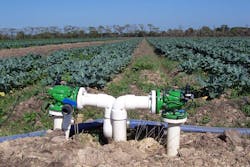Lack of Investment in Waterways Transport Could Threaten $32 Billion in GDP
The aging inland waterways system will limit U.S. agricultural exports during the next 25 years, putting 72 billion in additional GDP and 77,000 new jobs at risk, according to a new report Importance of Inland Waterways to U.S. Agriculture, from Agribusiness Intelligence.
“The U.S. is in direct competition with Brazil for its agricultural export business, particularly for corn and soybeans—two of our largest exports, therefore, infrastructure investments can have a tremendous impact upon a farmer’s profitability,” said Ken Eriksen, senior vice president of Agribusiness Intelligence’s consulting business and lead author of the study.
“Multinational corporations, including Chinese companies, are making significant investments in the Brazilian grain and soybean transportation and handling systems. While U.S. farmers currently have a cost advantage, if not addressed, U.S. infrastructure problems will erode that advantage, making U.S. grain and soybeans less competitive in global markets.”
The U.S. inland waterways system, much of which was built during the 1920s and 1930s, comprises the navigable areas of the upper and lower Mississippi River, the McClellan-Kerr Arkansas River, the Missouri River, the Illinois and Ohio River systems, the Tennessee River, and the Gulf Intracoastal Waterway. These waterways feed the Center Gulf, Mississippi River export grain complex of elevators that extend from Baton Rouge, La., through New Orleans to Myrtle Grove, La. This region handles 57% of U.S. corn export volumes valued at $4.8 billion and 59% of U.S. soybean exports valued at $12.4 billion.
“U.S. agriculture has long been the envy of the world, not only for its yields but also due to its ability to move grains, soybeans and other products to the global marketplace in a competitive, efficient and reliable manner thanks to a robust and expansive inland waterways transportation infrastructure,” Eriksen said. “However, that infrastructure is quite old—many of the locks are 80 years of age and far exceed their 50-year designed lifespans. The U.S. inland waterways infrastructure needs major rehabilitation and construction to restore it to its full capability, to forestall major disruptions, and provide opportunities for growth,” Eriksen said.
The study examined three scenarios that included potential impacts of reduced investment for U.S. waterways, maintaining the status quo of less than 2% growth, or increased investment of $6.3 billion during the next 10 years to help facilitate future export potential.
Currently, appropriated funds, which are considered maintaining the status quo, do not enable the U.S. Army Corps of Engineers to keep pace with barge-volume traffic, let alone growth or infrastructure maintenance and improvements needs, the study found. As a result, the percentage of vessels delayed on all waterways has increased from 35% in 2010 to 49% in 2017, which, in turn, adds to the total shipping cost.
Relative to the status quo scenario, the report estimates that by 2045, if inland waterway infrastructure is fully funded to meet the volume, maintenance and upgrades needs, employment will increase 20% to 472,000 jobs and the contribution to U.S. GDP would expand 39% to nearly $258 billion.
